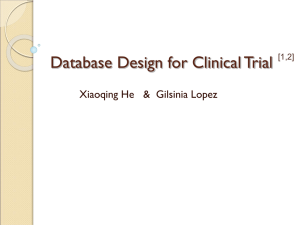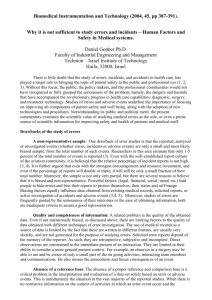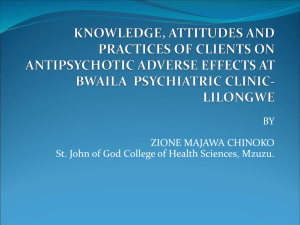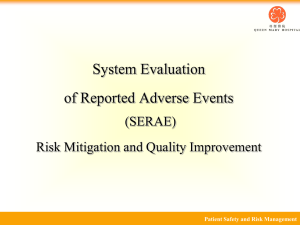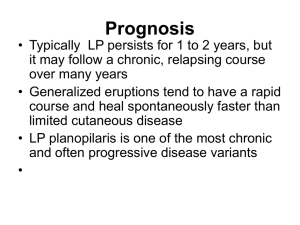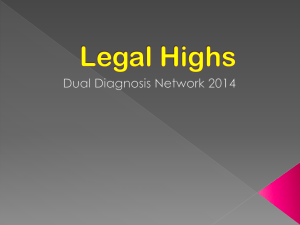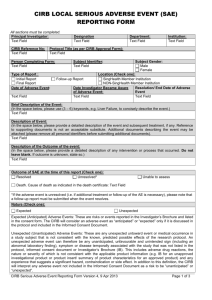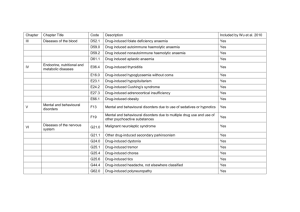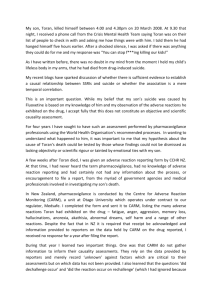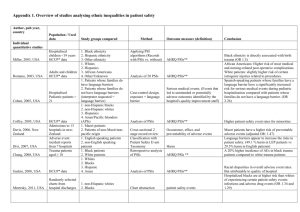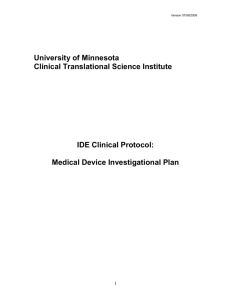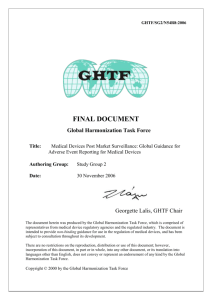drug reactions - Dr. Raj Kumar Sharma
advertisement
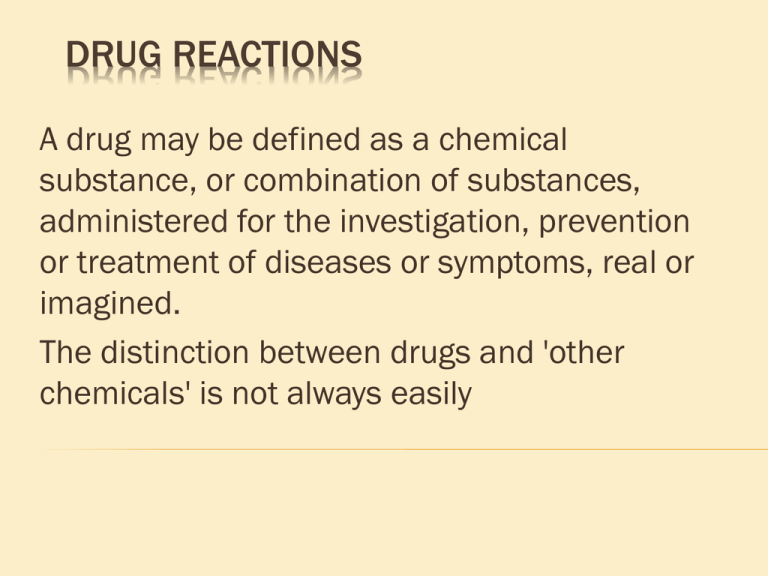
DRUG REACTIONS A drug may be defined as a chemical substance, or combination of substances, administered for the investigation, prevention or treatment of diseases or symptoms, real or imagined. The distinction between drugs and 'other chemicals' is not always easily Chemicals of very diverse structure are increasingly added to foods and beverages as dyes, flavours or preservatives. Chemicals used in agriculture or in veterinary medicine may contaminate human Advent of therapeutic agents that may be useful for improving the appearance, e.g minoxidil for androgenetic alopecia and tretinoin for photo-aged skin, the distinction between drugs and cosmetics has become blurred An adverse drug reaction - defined as an undesirable clinical manifestation resulting from administration of a particular drug at doses normally used for prophylaxix,diagnosis & threapy of diseases –WHO 1972 this includes reactions due to overdose, predictable side-effects and unanticipated adverse manifestations. Adverse drug reactions are the inevitable price we pay for the benefits of modern drug therapy. They are costly both in terms of the human illness caused in economic terms, can undermine doctor-patient relationship. Adverse drug reactions contribute to the need for hospitalization in 10-17% of elderly inpatients Inappropriate medication is a major cause of adverse drug reactions in elderly patients; 27% of elderly patients on medication admitted to a teaching hospital experienced adverse drug reactions, Adverse drug reactions occur in between 6 and 17% of children admitted to specialist paediatric hospitals The incidence of adverse drug reactions varies from 6 to 30%, with at least 90 million courses of drug treatment given yearly The reported percentage of patients who develop an adverse drug reaction during hospitalization varies markedly from 1.5 to 44%, Although in most studies the incidence is about 10-20% It has been estimated that about one in 40 consultations in general practice is the result of adverse drug reactions. the percentage of consultations involving an adverse drug reaction increased from 0.6% for patients aged 0-20 years to 2.7% for patients aged over 50 years The elderly persons have a significantly higher incidence of adverse drug reactions, related to decreased organ reserve capacity Altered pharmacokinetics and pharmacodynamics, polypharmacy CLASSIFICATION OF ADVERSE DRUG REACTIONS. Non-immunological Predictable Overdosage Side-effects Cumulation Delayed toxicity Facultative effects Drug interactions Metabolic alterations Teratogenicity Non-immunological activation of effectors pathways Exacerbation of disease Drug-induced chromosomal damage Unpredictable Intolerance Idiosyncrasy IMMUNOLOGICAL (UNPREDICTABLE) IgE-dependent drug reactions Immune complex-dependent drug reactions Cytotoxic drug-induced Cell-mediated reactions Miscellaneous Jarisch-Herxheimer reactions Infectious mononucleosis-ampicillin reaction IMMUNOLOGICAL DRUG REACTIONS IgE-dependent (type I) drug reactions: urticaria and anaphylaxis Antibody-mediated (type II) drug reactions Immune complex-dependent (type III) Vasculitis The Arthus reaction Cell-mediated reactions (type IV reactions) Erythema multiforme Stevens-Johnson syndrome“ Toxic epidermal necrolysis“ "Lichenoid drug eruptions Lupus erythematosus (LE)-like syndrome induced by drugs Drug-induced pemphigus &Pemhigoid Fixed drug eruptions DRUGS CAUSING EXANTHEMATIC REACTIONS. Ampicillin and penicillin Cephalosporins Phenylbutazone and other pyrazolones Barbiturates Sulphonamides Thiazides Phenytoin Naproxen Carbamazepine Isoniazid Gold Phenothiazines Gentamicin EXANTHEMATOUS REACTIONS EXANTHEMATOUS REACTIONS URTICARIA OR ANAPHYLAXIS Drugs causing are Animal sera Dextrans Antibiotics Angiotensin converting enzyme inhibitors Vasopressin Radiographic contrast media Non-steroidal anti-inflammatory drugs opiates, codeine, amphetamine, polymyxin B, tubocurarine, atropine, hydralazine, pentamidine, quinine and radiocontrast media - may release mast-cell mediators directly. Cyclo-oxygenase inhibitors, such as aspirin and indomethacin, DRUGS CAUSING PHOTOSENSITIVITY. Amiodarone Ampicillin Phenothiazines Antidepressants Chlorpromazine Tetracyclines Griseofulvin Demeclocyclin LICHENOID ERUPTIONS Drugs causing lichenoid eruptions. Antitubercular drugs Ethambutol Antimalarials Mepacrine (quinacrine, atebrin) Frusemide, diazoxide, tetracyclines, STEVENS-JOHNSON SYNDROME (S.J.S) & TOXIC EPIDERMAL NECROLYSIS (TEN) MULTIPLE MUCOSAL LESION SJS-TEN SJS-TEN STEVENS-JOHNSON SYNDROME (S.J.S) & TOXIC EPIDERMAL NECROLYSIS (TEN) Anti-epileptic drugs (phenytoin, barbiturates, carbamazepine and lamotrigine Ampicillin and other lactam antibiotics Sulphonamides (sulphadiazine, trimethoprimsulphamethoxazole, sulphadoxine), phenobarbital, chlormezanone DRUGS REPORTED TO EXACERBATE PSORIASIS Antimalarials Lithium salts Non-steroidal anti-inflammatory drugs Buprofen Indomethacin Meclofenamate sodium Pyrazolon derivatives (phenylbutazone, oxyphenbutazone) ACNE FORM ERUPTION Lesions are papulopustular but comedones are usually absent. Adrenocorticotrophic hormone (ACTH), corticosteroids Dexamethasone in neurosurgical patients, Anabolic steroids for bodybuilding Isoniazid may induce acne Danazol FIXE DRUG ERUPTIONS Fixed eruptions characteristically recur in the same site or sites each time the drug is administered Cross-sensitivity to related drugs may occur, such as between phenylbutazone and oxyphenbutazone and between tetracycline type drugs. Acute lesions usually develop 30 min to 8h after drug administration sharply marginated, round or oval itchy plaques of erythema and oedema becoming dusky violaceous or brown, and sometimes vesicular or bullous Lesions are solitary at first, but with repeated attacks new lesions usually appear and existing lesions may increase in size. Bullous fixed drug eruption Co-trimoxazole (trimethoprim-sulphamethoxazole), Tetracycline Ampicilline FDE GENITEL LESION FDE Hair changes Drug-induced alopecia Drug-induced hypertrichosis Drug-induced hair discoloration Nail changes Onycholysis Oral conditions Xerostomia THE MANAGEMENT OF DRUG REACTIONS Diagnosis Drug history Drug elimination Skin testing Patch testing In vitro tests Tests for IgE antibody - RAST Challenge tests Treatment Anaphylaxis Exfoliative dermatitis/erythroderma
